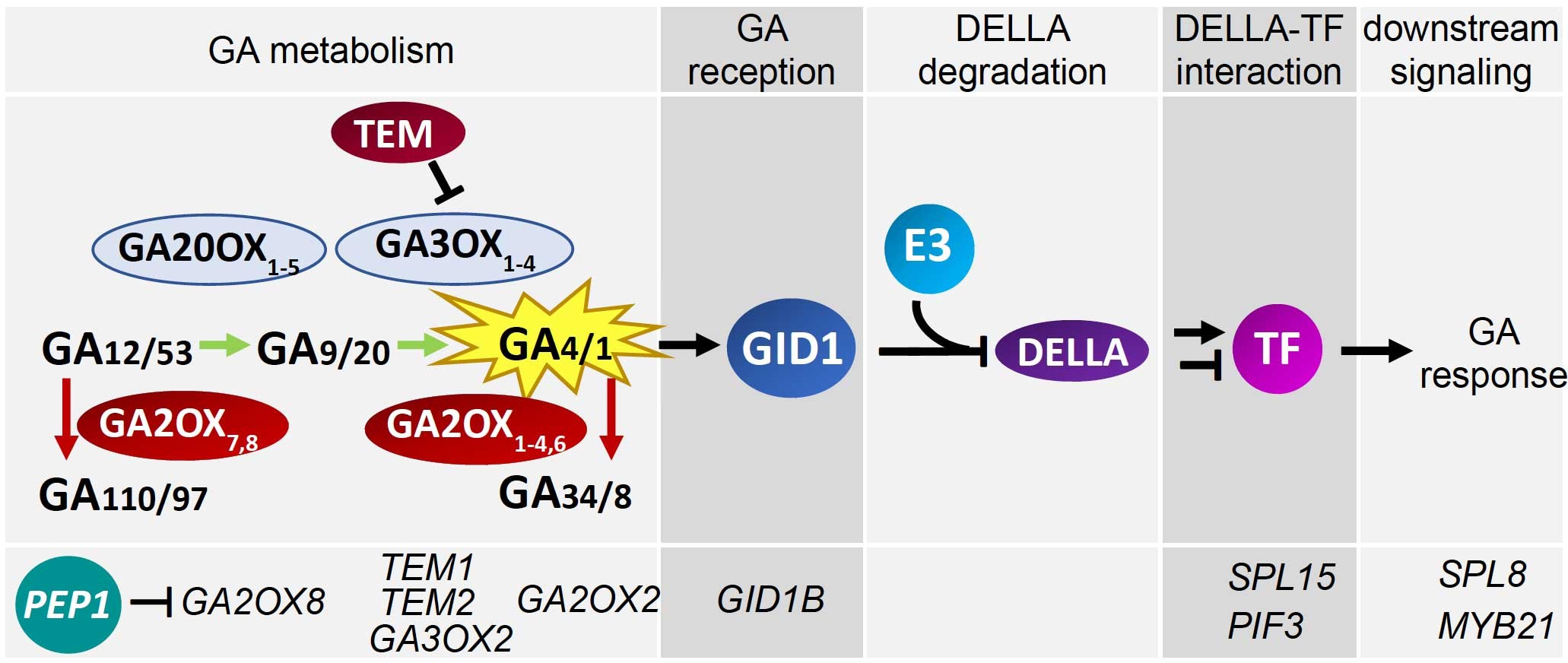博文
Plant Physiology:赤霉素作用于高山南芥春化过程中的成花诱导
||
Gibberellins act downstream of Arabis PERPETUAL FLOWERING 1 to accelerate floral induction during vernalization
First author: Vicky Tilmes; Affiliations: Max Planck Institute for Plant Breeding Research (马克斯普朗克植物育种研究所): Cologne, Germany
Corresponding author: George Coupland
Regulation of flowering by endogenous and environmental signals ensures that reproduction occurs under optimal conditions to maximize reproductive success. Involvement of the growth regulator gibberellin (GA) in the control of flowering by environmental cues varies among species. Arabis alpina Pajares, a model-perennial member of the Brassicaceae, only undergoes floral induction during vernalization, allowing definition of the role of GA specifically in this process. The transcription factor PERPETUAL FLOWERING 1 (PEP1) represses flowering until its mRNA levels are reduced during vernalization. Genome-wide analyses of PEP1 targets identified genes involved in GA metabolism and signaling, and many of the binding sites in these genes were specific to the A. alpina lineage. Here, we show that the pep1 mutant exhibits an elongated-stem phenotype, similar to that caused by treatment with exogenous GA, consistent with PEP1 repressing GA responses. Moreover, in comparison to the wild type, the pep1 mutant contains higher GA4 levels and is more sensitive to GA prior to vernalization. Upon exposure to cold temperatures, GA levels fall to low levels in the pep1 mutant and in wild-type plants, but GA still promotes floral induction and the transcription of floral meristem identity genes during vernalization. Reducing GA levels strongly impairs flowering and inflorescence development in response to short vernalization treatments, but longer treatments overcome the requirement for GA. Thus, GA accelerates the floral transition during vernalization in A. alpina, the downregulation of PEP1 likely increases GA sensitivity, and GA responses contribute to determining the length of vernalization required for flowering and reproduction.
通过内源和外源环境信号调控植物的开花可以保证植物在最适条件下进入生殖生长,从而最大化植物的生殖成功率。生长调控因子赤霉素参与由环境信号控制的开花过程在不同物种中差异很大。高山南芥是十字花科中研究多年生植物的典型代表,该植物只有在春化过程中经历成花诱导,使得作者能够研究GA在该过程中所扮演的作用。转录因子PEP1会抑制开花,而在春化过程中该转录因子的mRNA水平会逐步下降。全基因组PEP1的靶标分析鉴定了一些参与GA代谢和信号转导的基因,并且这些基因上很多结合位点是高山南芥这一支系所特有的。本文,作者的研究显示pep1突变体存在茎伸长的表型,与外施GA后的表型类似,该结果与PEP1抑制GA响应的假设吻合。此外,相比于野生型,pep1突变体中含有的GA4更多,并且在春化之前对于GA更加敏感。低温处理后,pep1突变体和野生型中GA均降低到一个比较低的水平,但春化过程中GA仍能够促进成花诱导和花分生组织特征基因的转录。降低GA的含量严重阻碍了短时间春化处理条件下植株的开花和花序发育,但长时间的春化处理能够克服GA缺少带来的问题。因此,GA能够加速高山南芥春化过程中的成花转变,PEP1的下调能够增加植株对GA的敏感性,并且GA响应作用于植物有效春化所需的时间长短。
通讯:George Coupland(https://www.mpipz.mpg.de/14666/Curriculum_Vitae)
个人简介:1977-1984年,格拉斯哥大学,学士;1981-1984年,爱丁堡大学,博士;1985-1988年,科隆大学、马克斯普朗克植物育种研究所,博士后。
研究方向:植物关键发育过程中的环境可塑性,最为典型的就是通过成花诱导起始植物的生殖生长。
doi: https://doi.org/10.1104/pp.19.00021
Journal: Plant Physiology
First Published: May 16, 2019
https://blog.sciencenet.cn/blog-3158122-1179611.html
上一篇:Nature Genetics:番茄泛基因组
下一篇:Science Advance:拟南芥R环“读取”蛋白
全部作者的其他最新博文
- • Plant Physiology:CsMADS3促进柑果中的叶绿素降解和类胡萝卜素合成(华中农业大学)
- • Molecular Plant:LBD11-ROS反馈调节作用于拟南芥的维管形成层增殖和次生生长(浦项科技大学)
- • Science Advances:根结线虫通过调控植物的CLE3-CLV1模块,促进侵染进程(日本熊本大学)
- • Nature Communications:油菜素内酯参与植物营养生长期转变的分子机制解析(浙江农林大学)
- • Current Biology:光合作用产生的蔗糖驱动侧根“生物钟”(德国弗莱堡大学)
- • PNAS:花同源异型基因在叶中被抑制、花中被激活的分子机制(南卡罗来纳大学)

